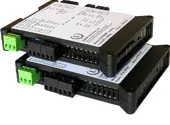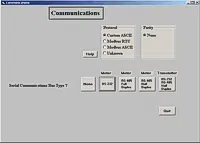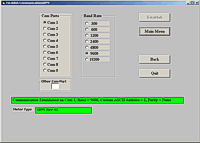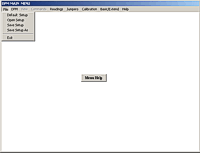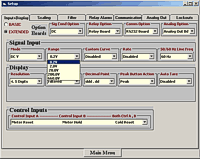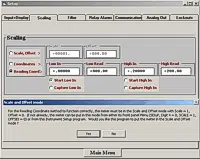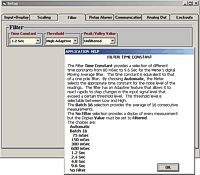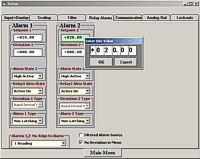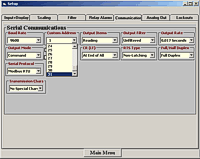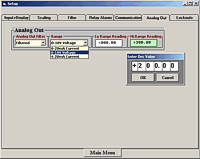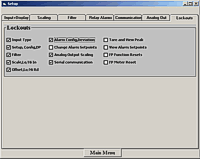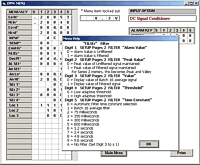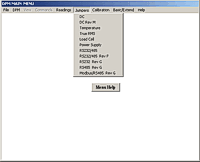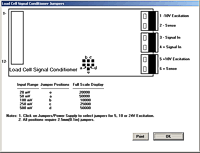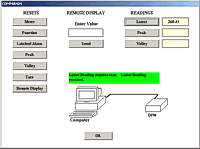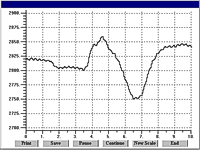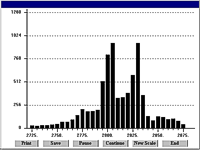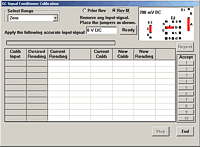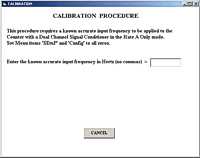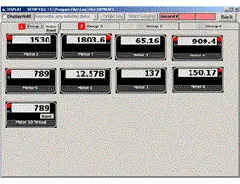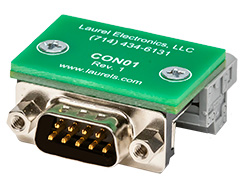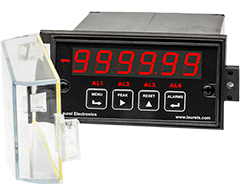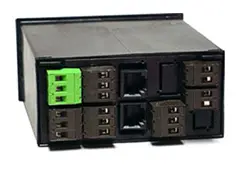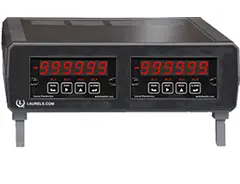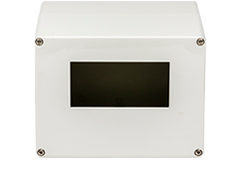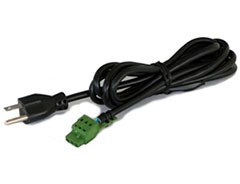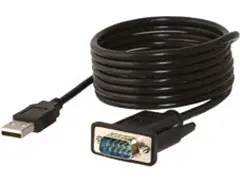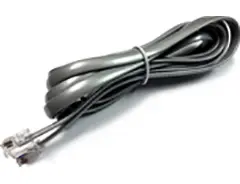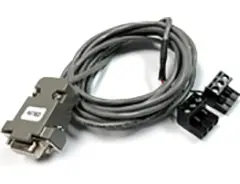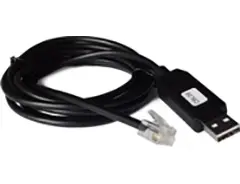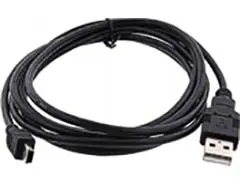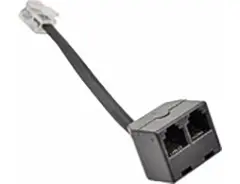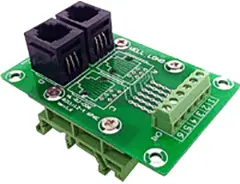- Description
- Specifications
- Setup Software
- Mechanical
- Documents
- Technical FAQ
- Applications
- Accessories
Features
- 0.2, 2, 20, 200, 300 & 600V AC or AC+DC voltage ranges
- 2, 20, 200 mA & 5A AC or AC+DC current ranges
- Accuracy to 0.03% of full scale, 0.1% to 100% of FS, 10 Hz to 5 kHz
- 0.03% accuracy of full scale at crest factor to 3.0
- True RMS AC measurement with crest factor of 3.0 at full scale
- Measurements from 0% to 100% of full scale
- AC or DC coupling for signals from DC to 5 kHz
- Fast response: reading in 0-16.7 ms after each signal cycle to full accuracy
- All input ranges are user selectable and factory calibrated
- Up to 60 conversions per second, Ideal for peak or valley capture
- Digital span adjust from 0 to ±99,999, zero adjust from -99,999 to +99,999
- Front panel scalable to ±99,999 for use with current shunts
- 1/8 DIN size with bright red or green 0.56" (14.2mm), high LED digits
- Power 85-264 Vac / 90-300 Vdc or 10-48 Vdc / 12-32 Vac (isolated)
- Operating temperature from -40°C to 70°C (-40°F to 158°F)
- Wide choice of Plug-in-Play options:
- 2 or 4 relays, mechanical or solid state, for alarm or control (isolated)
- 1 or 2 Analog output, 4-20 mA, 0-20 mA, 0-10V, or -10V to +10V (isolated)
- Communications: Ethernet, WiFi, USB, RS232, RS485 (isolated)
- Extended DPM allows up to 180 data points for custom curve linearization
and a rate derived from consecutive readings
Certificates of Compliance

The Laureate™ 1/8 DIM Panel Meters for True RMS
is a 60,000 count panel meters with exceptional performance at half the price of a bench top meter. It can measure true RMS voltages or current of AC signals where there is considerable distortion of the waveform, such as rectifier outputs or waveforms chopped by an SCR, TRIAC or transistor circuit, as illustrated.- True RMS readings in 0-16 ms after completion of one input signal cycle allow anomalies to be detected and alarmed before they become expensive problems. Fast On/Off control and alarm can be achieved with optional dual or quad relays, either contact or solid state. The panel meters can also capture peak and valley readings that occur at the nominal rate of 50/60 Hz.
- Accuracy is 0.03% of full scale with the panel meter's standard 1 Megohm input resistance, signals from DC to 5 kHz, and signal amplitudes down to 0.1% of full scale. A version with 10 Megohm input resistance is available as a factory special, but decreases the maximum frequency from 5 kHz to 1 kHz for three of the voltage ranges.
 The crest factor (Vp / Vrms) is 3.0 at full-scale Vrms of 20,000 counts and a Vp of 60,000 counts. The panel meters start to flash overrange at 132% of full scale Vrms, at which point the available crest factor is 60,000 / 26,400 = 2.27. Meaningful readings with rated resolution continue to be obtained up to 212% of full scale Vrms (42,433 counts) for sinusoidal signals, at which point the available crest factor is 1.414. For safety reasons, the maximum RMS input signal should never exceed 600V or 5A. ETL certification is for a maximum voltage of 300 Vrms.
The crest factor (Vp / Vrms) is 3.0 at full-scale Vrms of 20,000 counts and a Vp of 60,000 counts. The panel meters start to flash overrange at 132% of full scale Vrms, at which point the available crest factor is 60,000 / 26,400 = 2.27. Meaningful readings with rated resolution continue to be obtained up to 212% of full scale Vrms (42,433 counts) for sinusoidal signals, at which point the available crest factor is 1.414. For safety reasons, the maximum RMS input signal should never exceed 600V or 5A. ETL certification is for a maximum voltage of 300 Vrms.- AC or DC coupling is jumper selectable. AC coupling is suitable for applications such as measuring the ripple on a DC power supply. Multiple integral cycles are averaged for signals above 50/60 Hz. A single cycle is captured for signals from 3 Hz to 50/60 Hz. Below 3 Hz and at DC, the capture rate is every 333 ms.

Use with current Transformers. High common mode rejection allows stable readings with current shunts located on the high side of the line. Five amp input capability allows the output of 5A current transformers to be applied directly to the panel meters, with no need for a stepdown transformer. The panel meters readings can easily be scaled for the current transformer ratio. Digital filtering is selectable for noisy signals.
All signal conditioner board ranges are factory-calibrated, with calibration factors for each range securely stored in an onboard EEPROM. These factors can be scaled via software to accommodate external shunts, enabling field replacement of signal conditioner boards without necessitating recalibration of the associated panel meters. For optimal accuracy, factory recalibration is recommended annually. All Laurel Electronics instruments undergo factory calibration using the industry-leading Fluke calibrators, which are recalibrated yearly and certified traceable to national standards, ensuring the highest level of precision and reliability.
The optional extended Laureate computer board enhances Laureate Panel Meters by displaying rates derived from successive readings and enabling highly accurate custom curve linearization. For example, it can calculate liquid volume or flow rate in a horizontal cylindrical tank using levels from a 4-20 mA transmitter. Setup is straightforward: users input up to 180 data points into a spreadsheet or text file, and the computer calculates spline-fit segments, which are then downloaded to the panel meters for precise operation.
Laureate Panel Meters are easily programmed with Laurel’s free Instrument Setup Software, downloadable from our website and compatible with Windows PCs, requiring a data interface board for setup.
High read rate of up to 50 or 60 conversions per second, the Laureate™ Panel Meters use Concurrent Slope (US Pat. 5,262,780) analog-to-digital conversion to integrate signals over a full power line cycle (50 Hz or 60 Hz). This read rate enables peak and valley capture, real-time computer interfacing, and control applications. Peak and valley values are automatically captured and can be viewed using Laurel’s free Instrument Setup Software (compatible with Windows PCs) or transmitted as serial data.
- An unfiltered selection provides true peak and valley readings and aids in control applications.
- A batch average filter selection averages each 16 conversions.
- An adaptive moving average filter selection provides a choice of 8 time constants from 80 ms to 9.6 seconds. When a significant change in signal level occurs, the filter adapts by briefly switching to the shortest time to follow the change, then reverts back to its selected time constant. An Auto setting selects the time constant selection based on signal noise.
Two tare functions: auto-tare and manual tare. In auto-tare, an input line is grounded by an external pushbutton. In manual tare, the tare value can be entered manually via the front panel or a computer using Laurel's free Instrument Setup Software.
Peak and valley values are automatically captured. These may be displayed via a front panel pushbutton command or control signal at the rear connector, or be transmitted as serial data.
Two rear panel control Inputs (CMOS/TTL levels, logic 0 = tied to digital ground, logic 1 = open) or dry contacts that can be set to control / activate 14 meter commands.
AC Voltage
| AC Voltage FS Range |
AC Voltage to Overrange Flash |
Resolution | Input Resistance |
Error at 25°C |
|---|---|---|---|---|
| 200.00 mV | 264.00 mV | 10 µV | 1 MΩ |
± 0.03% of FS ± 2 cts, 0-100% of FS |
| 2.0000 V | 2.640 V | 100 µV | ||
| 20.000 V | 26.400 V | 1 mV | ||
| 200.00 V | 264.00 V | 10 mV | ||
| 300.0 V |
650 V | 0.1 V | ± 0.8 V | |
| 600.0 V* | 650 V | 0.1 V | ± 0.8 V | |
| * Range not ETL certified. For purposes of accuracy calculation, the 600V range is 2000V (20,000 counts). | ||||
| Recalibration: All ranges are calibrated at the factory. Recalibration is recommended every 12 months. | ||||
AC Current
| AC Current Range | AC Current to Overrange Flash |
Resolution | Input Resistance | Error at 25°C |
|---|---|---|---|---|
| 2.0000 mA | 264.00 µA | 0.1 µA | 100 Ω | ± 0.03% of FS ± 2 cts, 0-100% of FS |
| 20.000 mA | 26.400 mA | 1.0 µA | 10 Ω | |
| 200.00 mA | 264.00 mA | 10 µA | 1 Ω | |
| 5.000 A | 5.4 A | 1 mA | 0.01Ω | ± 20 mA |
| * For purposes of accuracy calculation, the 5A range is 20A (20,000 counts). | ||||
| Recalibration: All ranges are calibrated at the factory. Recalibration is recommended every 12 months. | ||||
Both AC Voltage & Current
| Display | |
|---|---|
| Readout | 5 LED digits, 7-segment, 14.2 mm (.56"), red or green |
| Range | -99999 to 99999 or -99990 to 99990 (count by 10) |
| Display Update Rate | 3.75/s at 60 Hz power, 3.1/s at 50 Hz power |
| Indicators | 1 LED lamp per relay setpoint |
| Crest factor Vp / Vrms | 3.00 at full scale range |
| Output Update Rate | |
| A-to-D rate | 60/s at 60 Hz power, 50/s at 50 Hz power |
| Signals > 50/60 Hz | 60/s at 60 Hz power, 50/s at 50 Hz power |
| Signals 3 Hz to 50/60 Hz | Same as signal frequency |
| Signals DC to 3 Hz | 3 per second |
| Maximum Signal | |
| Max applied voltage | 600 Vac for 2, 20, 200, 600V ranges, 35 Vac for 0.2V range |
| Current protection |
25x for 2 mA, 8x for 20 mA, 2.5x for 200 mA, 1x for 5A |
| Power Supply Boards (one required) | |
| Voltage, standard | 85-264 Vac or 90-300 Vdc |
| Voltage, optional | 12-32 Vac or 10-48 Vdc |
| Frequency | DC or 47-63 Hz |
| Power consumption (typical, base meter) | 1.2W @ 120 Vac, 1.5W @ 240 Vac, 1.3W @ 10 Vdc, 1.4W @ 20 Vdc, 1.55W @ 30 Vdc, 1.8W @ 40 Vdc, 2.15W @ 48 Vdc |
| Power Isolation | 250V rms working, 2.3 kV rms per 1 min test |
| Analog Output Board (one optional) | |
| Output levels | 4-20 mA, 0-20 mA, 0-10V, -10 to +10V (jumper selectable) |
| Current compliance | 2 mA at 10V ( > 5 kΩ load) |
| Voltage compliance | 12V at 20 mA (< 600 Ω load) |
| Scaling | Zero and full scale adjustable from -99999 to +99999 |
| Resolution | 16 bits (0.0015% of full scale) |
| Step function response | 80 ms to 99% of final value (typ) |
| Isolation | 250V rms working, 2.3 kV rms per 1 min test |
| Relay Output Boards (one optional) | |
| Dual magnetic relays | 2 Form C, 10A max, 440Vac or 125Vdc max, 2500VA or 300W |
| Quad magnetic relays | 4 Form A (NO), 10A max, 440Vac or 125Vdc max, 2500VA or 300W |
| Dual solid state relays | 2 Form A (NO), AC or DC, 0V - 400V, 120Ma, 35Ohms (max at On-State) |
| Quad solid state relays | 4 Form A (NO), AC or DC, 0V - 400V, 120Ma, 35Ohms (max at On-State) |
| Relay commons | Isolated commons for dual relays or each pair of quad relays |
| Relay isolation | 250V rms working, 2.3 kV rms per 1 minute test |
| Step function response | 30 ms (typ) for contact relays, 25 ms (typ) for solid state relays |
| Relay latching modes | Latching or non-latching |
| Relay active modes | Active on or off, active high or low |
| Hysteresis modes | QA passband mode, split hysteresis, span hysteresis |
| Communication Boards (one optional) | |
| Board selections | RS232, RS485 with dual RJ11 connectors, RS485 with dual RJ45 connectors, USB, Ethernet, USB-to-RS485 gateway, Ethernet-to-RS485 gateway, WiFi with built-in antenna plus USB & RS485, WiFi with external antenna plus USB & RS485 |
| Protocols | Laurel Custom ASCII (serial), Modbus RTU (serial), Modbus TCP (Ethernet or WiFi) |
| Digital addresses | 247 (Modbus), 31 (Laurel ASCII), |
| Isolation | 250V rms working, 2.3 kV rms per 1 min test |
| Signal Connections | |
 |
|
| Environmental | |
| Operating temperature | -40°C to 70°C (-40°F to 158°F) |
| Storage temperature. | -40°C to 85°C (-40°F to 185°F) |
| Relative humidity | 95% at 40°C, non-condensing |
| Protection | NEMA-4X (IP-65) when panel mounted |
| Mechanical | |
| Enclosure | 1/8 DIN, high impact plastic, UL 94V-0, color: black |
| Mounting | 1/8 DIN panel cutout required: 3.622" x 1.772" (92 mm x 45 mm). |
| Dimensions | 4.68" x 2.45" x 5.64" (119 mm x 62 mm x 143 mm) (W x H x D) |
| Maximum panel thickness | 4.5 mm (0.18") |
| Tightening Torque - Connectors | Screw terminal connectors: 5 lb-in (0.56 Nm) |
| Tightening Torque - Pawls | Digital Panel Meter Case Pawls: 5 lb-in (0.56 Nm) |
| Weight of base meter | 210 g (7.4 oz) typical (DPM, counter, timer, 6-digit remote display) |
| Weight of option boards | 30 g (1.0 oz) typical per board (analog output, relay output, communications) |
| General | |
| Programming Methods | Four front panel buttons or via Laurel's free Instrument Setup Software, which runs on a PC under MS Windows. |
| Security | Lockout options include using the front panel buttons, the free Instrument Setup Software, or a hardware jumper. |
| Warranty | 3 years parts & labor |
| Recalibration: All ranges are calibrated at the factory. Recalibration is recommended every 12 months. | |
Free Instrument Setup Software for Series 2 Laureates
Free Downloadable Windows-based Instrument Setup (IS) software (Data Interface Board Required) for use with our programmable Digital Panel Meters, Scale Meters, Counters, Timers, Remote Displays, and Transmitters, are an easy method to set up Laureate 1/8 DIN digital panel meters, counters, timers, remote displays, and DIN-rail transmitters, as explained in the Instrument Setup Software Manual. Laureate 1/8 DIN instruments can also be set up from the front panel, as explained in their respective Owners Manuals. Instrument Setup software is of benefit whether or not the PC is connected to the instrument.
- When the PC is connected to the instrument, Instrument Setup software can retrieve the setup file from the instrument or open a default setup file or previously saved setup file from disk View Setup, then provides graphical user interface (GUI) screens with pull-down menus applicable to input, display, scaling, filtering, alarms, communications, analog output, and front panel lockouts. Fields that are not applicable to the instrument as configured are either left out or grayed out. Clicking on any item will bring up a detailed Help screen for that item. After editing, the setup file can be downloaded, uploaded to the instrument, or saved to a disk. The same setup file can then be downloaded into multiple instruments.
- When the PC is not connected to the instrument, the above GUI screens can be used to set up a virtual instrument. The setup file can then be saved to disk. Switching toView Menu then brings up a screen with the required front panel programming steps. This view can be printed out for use at the instrument site and to serve as a hard copy record.
Download Free Instrument Setup Software
Installation
Set User Account Control (UAC) of MS Windows to "Never notifiy me" so that Instrument Setup Software can create directories. The UAC change screen can be reached as follows:
- Under Windows 7, click on the Windows Start button in the lower left of the desktop and enter "UAC" in the search field.
- Under Windows 8, navigate to Control Panel, then to the "User Accounts and Family Safety" section, and click on "Change User Account Control Settings."
- Under Windows 10, click on the Windows Start button in the lower left of the desktop, then on "Settings", and enter "UAC" in the search field.
- Reboot your computer for the changed UAC setting to take effect.

RJ11-to-DB9 cable with rear view of DB9 connector to PC
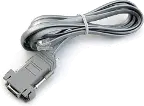
RS232 cable, meter to PC, P/N CBL01
Laureate 1/8 DIN Laureate instruments must be equipped with a serial communications board and be connected to the computer via a serial communications cable. The connection can be via RS232, RS485, USB or Ethernet. Following setup, the serial communications board may be removed from the instrument if desired. The wiring of the RS232 cable is illustrated above with end views of the two connectors.
Laureate LT Series transmitters come standard with a 3-wire serial interface, which can be jumpered for RS232 or RS485.
Laureate LTE Series transmitters come standard with an Ethernet interface.
Meter Setup Screens
Click on any of the reduced screens below for a full-size screen view, then click on the Back button of your browser to return to this page. The screens examples below are for a fully-loaded Series 2 Digital Panel Meter (DPM), which is connected to the PC via RS232. If the meter is a Series 1 meter (pre-2007), this is sensed by the software, and somewhat different screens are brought up. Please see Series 1 setup screens.











Meter Setup Utilities




From the Main Menu, click on Readings if your PC is connected to the meter. A pull-down menu then offers three choices: List, Plot and Graph.
- List presents the latest readings in a 20-row by 10-column table. Press Pause at any time to freeze the display. This is one method to capture peak readings.
- Plot generates a plot of readings vs. time in seconds. It effectively turns the DPM-PC combination into a printing digital oscilloscope.

- Graph generates a histogram where the horizontal axis is the reading and the vertical axis is the number of occurrences of readings. The display continually resizes itself as the number of readings increases.



Laureate™ 1/8 DIN Case For Laureate Digital Panel Meters, Counters, Timers & Remote Displays
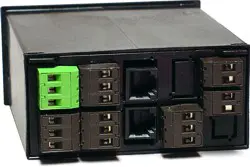
Key Features
- Meets 1/8 DIN Standard.
- Installs from front of panel.
- Short depth behind the panel: only 4" (102 mm) plus connectors.
- Understated 0.157" (4 mm) thick bezel.
- Meets NEMA 4X (IP-65) for high-pressure wawshdon when panel mounted.
- Screw clamps connectors meet VDE / IEC / UL / CSA safety standards.
- Rugged GE Lexan® housing material.
- Safety certified per EN 61010-1.
Dimensions
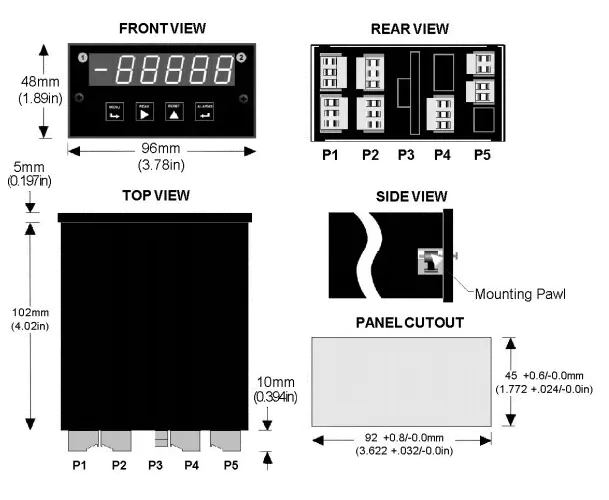
Maximum panel thickness: 4.5 mm (0.18")
Weight of base meter: 210 g (7.4 oz) typical (DPM, counter, timer, 6-digit remote display)
Weight of option boards: 30 g (1.0 oz) typical per board (analog output, relay output, communications)
Tightening Torque - Connectors: Screw terminal connectors: 5 lb-in (0.56 Nm)
Tightening Torque - Pawls: Digital Panel Meter Case Pawls: 5 lb-in (0.56 Nm)
Dimensioned CAD assembly drawings in EPRT, STEP, x_t. dwg, pdf file formats: Laureate-meter-case.zip (zipping prevents browser from opening CAD files as text files).
Panel Mounting
 Slide the meter into a 45 x 92 mm 1/8 DIN panel cutout. Ensure that the provided gasket is in place between the front of the panel and the back of the meter bezel.
The meter is secured by two pawls, each held by a screw, as illustrated. Turning each screw counterclockwise extends the pawl outward from the case and behind the panel. Turning each screw clockwise further tightens it against the panel to secure the meter.
Slide the meter into a 45 x 92 mm 1/8 DIN panel cutout. Ensure that the provided gasket is in place between the front of the panel and the back of the meter bezel.
The meter is secured by two pawls, each held by a screw, as illustrated. Turning each screw counterclockwise extends the pawl outward from the case and behind the panel. Turning each screw clockwise further tightens it against the panel to secure the meter.
Turning each screw counterclockwise loosens the pawl and retracts it into its well. This position allows installed meter to be removed from their panel, or new meters to be installed in a panel. Do not remove the screws from their pawls. Doing so would cause the screw and pawl to fall off and likely get lost. Do not overtighten so as not to damage the plastic parts.
AC RMS Digital Panel Meter Frequently Asked Technical Questions
Using Laureate Meters to Synchronize Two Motor Generators
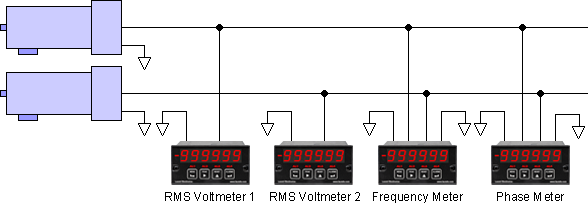
Successful synchronization of two motor generators requires that the voltage outputs of the generators be close to each other, that the two frequencies be identical, and that the voltage waveshapes be in phase.
- The two voltages can be measured by two Laureate AC RMS Voltmeters, which offer 200.00 V and 600.0 V ranges. Or a single meter can be multiplexed by using an external toggle switch.
- Two frequencies A & B can be measured to six-figure accuracy by a single Laureate Dual Channel Counter, where each channel monitors a generator. The two AC neutrals must be tied to meter ground. Pressing a front-panel key toggles the reading between the channels. The meter can also display frequency A - frequency B, or frequency A / frequency B without toggling.
- Phase angle can be measured using the Laureate Phase Meter.
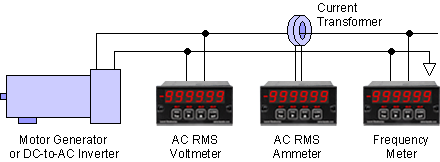
Why Measure AC Power?
Many AC loads, such as electrical motors, will only operate reliably if the AC line voltage and frequency are within specified tolerances; otherwise permanent damage to expensive plant equipment may occur. Drops in line voltage or frequency may indicate an excessive load and the possibility of equipment damage. Laureate meters and counters are low-cost means to instrument and alarm AC power lines with great accuracy:
- AC RMS Voltmeter and Ammeter, as documented in this page. True RMS capability allows the display of RMS voltage for non-sinusoidal waveshapes, such as square waves from a UPS. A built-in 5 A range can be used to display currents up to 5.000 A with 1 mA resolution or accept the output of 5 A current transformers. The 200.00 mV range can be used with external current shunts. With either transformers or shunts, scaling of the input current is easily accomplished via the meter's front panel pushbutton switches.
- Frequency Meter. Inverse period is used to determine AC line frequency to six-figure accuracy (60.0000 or 50.0000) in a few line cycles plus 30 ms.
- Phase Angle & Power Factor Meter. Two signals with identical periods are applied to Channels A and B. A phase angle resolution of 1%, 0.1% or 0.01% is selectable. Accuracy is .01% up to 100 Hz, .1% at 1 kHz, and 1% at 10 kHz.
DLS-XLOG2
XLog2 Data logging Software
CON01
CON01 Connector
IPC
Splashproof Cover
CBL01
RS232 Cable for Meters
CBL02
USB-to-RS232 Adapter Cable
CBL04
RS232 Cable for LT Transmitters
CBL05
USB Data Cable for Meters
CBL06
USB-to-RS485 Adapter Cable
CBL07
USB Programming & Data Cable
CBL08
RS485 Splitter Cable
BKBD
RS485 RJ11 Terminal Block Adapter
Modular Design for Maximum Flexibility at Minimum Cost
All boards are isolated from meter and power grounds. Optional Plug-in-Play boards for communications and control include Ethernet, WiFi, serial communication boards, dual or quad relay boards, and an analog output board. Laureates may be powered from 85-264 Vac or optionally from 12-32 Vac or 10-48 Vdc. The display is available with bright red or green 0.56" (14.2mm) high LED digits. The 1/8 DIN case meets NEMA 4X (IP65) specifications from the front when panel mounted. Any setup functions and front panel keys can be locked out for simplified usage and security. A built-in 5, 10, 12, or 24 Vdc excitation supply can power transducers, eliminating the need for an external power supply. All power and signal connections are via UL / VDE / CSA rated screw clamp plugs.
The Laureate™ Series features modular design with up to 7 isolated plug-in boards, applicable to all Laureate 1/8 DIN Panel Meters.

Modular Hardware
The design of the Laureate™ Series is modular for maximum flexibility at minimum cost. All boards are isolated from meter and power grounds. The base configuration for panel meters or counter consists of a main module (with computer and plug-in display boards), a power supply board, and a signal conditioner board. Optional plug-in-play boards include an isolated setpoint controller board, an isolated analog output board, and an isolated digital interface board. Modular design and a choice of plug-in options allow the Laureate to be customized for a broad range of applications from simple monitoring to control and computer interface. There can be up to five plug-in boards in a 1/8 DIN Laureate.

Connecting Laureate Panel Meters to a Local Area Network (LAN)
Up to 30 Laureate Panel Meters and/or LT Transmitters can be configured for RS485 and daisy-chained to an LT Transmitter using Laurel’s High Speed Ethernet-to-RS485 converter board for seamless LAN integration. Alternatively, Laurel LTE series Ethernet transmitters can connect directly to a LAN via an Ethernet cable. Setup for both configurations is streamlined using Laurel’s free Instrument Setup Software, which simplifies node discovery and transmitter configuration.
Flexible Communication Options for Panel Meters
Laureate Panel Meters can be equipped with Laurel communication boards to support various interfaces and protocols. These include serial interfaces with ASCII or Modbus RTU protocols, and Ethernet interfaces with web access, ASCII, or Modbus TCP/IP protocols, ensuring versatile connectivity for your commercial applications.

What are 1/8 DIN Panel Meters for True RMS AC Voltage?
1/8 DIN Panel Meters for True RMS AC Voltage are specialized electronic devices used in various industrial and commercial applications to measure and display the true root mean square (RMS) value of alternating current (AC) voltage. These Panel Meters are essential in environments where accurate measurement of AC voltage is critical, such as in power systems, electrical equipment, and industrial automation. Their ability to handle complex, non-sinusoidal waveforms ensures precise monitoring, making them invaluable for maintaining system efficiency and safety.
1/8 DIN Form Factor
The term 1/8 DIN refers to the standardized physical size and mounting style of these Panel Meters. DIN stands for Deutsches Institut für Normung, the German Institute for Standardization, which defines uniform dimensions for industrial components. 1/8 DIN Panel Meters have a front panel size of approximately 96mm x 48mm (3.78 inches x 1.89 inches), making them compact and ideal for integration into control panels where space is limited, without compromising functionality.
True RMS Measurement
True RMS (Root Mean Square) measurement is a defining feature of these Panel Meters. In AC circuits, voltage waveforms can be sinusoidal or non-sinusoidal, with distortions caused by harmonics or non-linear loads. Unlike average-responding panel meters, which assume a pure sine wave and may provide inaccurate readings for distorted waveforms, True RMS Panel Meters accurately calculate the equivalent DC voltage that would produce the same heating effect in a resistive load, regardless of waveform shape. This precision is crucial in modern electrical systems with devices like variable frequency drives (VFDs), switching power supplies, and other electronics that generate complex waveforms.
Key Features and Benefits
-
Compact Size: The 1/8 DIN form factor allows these Panel Meters to fit seamlessly into crowded control panels, optimizing space while delivering robust functionality.
-
High Accuracy: True RMS measurement ensures precise voltage readings, even for non-sinusoidal waveforms, which is critical for reliable monitoring and control in complex electrical systems.
-
Digital Display: Equipped with clear, high-visibility LED or LCD displays, these Panel Meters offer adjustable brightness for readability in various lighting conditions.
-
Versatility: Suitable for a wide range of applications, including power supplies, motor drives, generators, and other AC-powered equipment, these Panel Meters adapt to diverse monitoring needs.
-
Ease of Installation: Designed for straightforward panel mounting, these Panel Meters feature user-friendly interfaces and standard connections, simplifying setup and integration.
-
Robust Construction: Built with rugged enclosures and high IP ratings (e.g., IP65), these Panel Meters withstand harsh industrial environments, including dust and moisture.
Technical Specifications
Typical specifications for 1/8 DIN Panel Meters for True RMS AC Voltage include:
- Input Range: 0-600V AC or higher, depending on the model.
- Accuracy: ±0.1% of full scale or better.
- Display: 4-6 digit LED or LCD with customizable brightness and decimal points.
- Power Supply: 12-24V DC or 85-265V AC.
- Communication: RS-232, RS-485, Modbus RTU, or Ethernet for integration with control systems.
- Environmental Rating: IP65 or higher for front panel protection.
- Operating Temperature: -10°C to 50°C, suitable for industrial environments.
Applications
1/8 DIN Panel Meters for True RMS AC Voltage are widely used in industries where precise voltage monitoring is essential. Key applications include:
- Power Distribution: Monitoring voltage levels in distribution panels to ensure consistent and safe operation of electrical systems.
- Industrial Automation: Tracking voltage in control panels to maintain safe operating ranges for machinery and processes.
- HVAC Systems: Measuring voltage supplied to motors and compressors in heating, ventilation, and air conditioning systems to optimize performance.
- Laboratory Testing: Providing accurate voltage measurements for research and development projects, ensuring reliable test results.
- Renewable Energy: Monitoring AC voltage in solar inverters or wind turbine systems to optimize energy conversion and output.
Conclusion
1/8 DIN Panel Meters for True RMS AC Voltage are vital tools for professionals managing or monitoring AC voltage in electrical systems. Their compact size, coupled with their ability to accurately measure true RMS values for both sinusoidal and non-sinusoidal waveforms, makes them essential for ensuring reliability and safety in modern electrical environments. Whether in industrial automation, power distribution, or laboratory testing, these Panel Meters deliver the precision and functionality needed for demanding applications.
Where Are 1/8 DIN Panel Meters for True RMS AC Voltage Used?
Introduction
1/8 DIN Panel Meters are critical instruments in various industries for monitoring and displaying electrical parameters such as voltage, current, and frequency. When designed for True RMS AC voltage measurement, these Panel Meters become indispensable in environments requiring high accuracy for complex waveforms. Their compact size and robust features make them ideal for integration into control systems across diverse applications. This section explores the key industries and use cases where these Panel Meters are deployed.
Understanding True RMS Measurement
True RMS (Root Mean Square) measurement calculates the effective value of an AC voltage waveform, providing an accurate representation of the power delivered, regardless of waveform shape. Unlike average-responding meters, which can misinterpret non-sinusoidal waveforms, True RMS Panel Meters ensure precise measurements in systems with harmonic distortions, making them essential for modern electrical applications.
Key Applications of 1/8 DIN Panel Meters for True RMS AC Voltage
-
Industrial Automation and Control Systems
In industrial environments, 1/8 DIN Panel Meters monitor AC voltage supplied to machinery, ensuring optimal operation. True RMS measurement is critical for handling non-linear loads from equipment like variable frequency drives (VFDs) or robotic systems, preventing voltage-related issues and extending equipment lifespan.
-
Power Distribution and Monitoring
Power distribution systems rely on 1/8 DIN Panel Meters to monitor voltage in switchgear, transformers, and distribution panels. Accurate True RMS measurements detect anomalies caused by harmonic distortions, ensuring stable power delivery and preventing equipment failures or outages.
-
Renewable Energy Systems
In solar inverters and wind turbines, where non-sinusoidal waveforms are common, these Panel Meters monitor AC voltage to optimize energy conversion and grid integration. They ensure efficient performance and help detect issues like voltage fluctuations or harmonic distortions.
-
HVAC Systems
Heating, ventilation, and air conditioning systems use 1/8 DIN Panel Meters to monitor voltage supplied to motors, compressors, and fans. True RMS measurement ensures accurate readings despite waveform distortions, maintaining system efficiency and reliability.
-
Laboratory and Testing Environments
In laboratories, these Panel Meters provide precise voltage measurements for experiments and equipment testing. Their True RMS capability ensures accurate data for sensitive instruments, reducing errors in research and development projects.
-
Data Centers and IT Infrastructure
Data centers use 1/8 DIN Panel Meters to monitor AC voltage in power supply lines, ensuring stable operation of critical IT equipment. True RMS measurements help detect voltage irregularities, preventing downtime and protecting sensitive hardware.
-
Marine and Aerospace Applications
In marine and aerospace systems, these Panel Meters monitor AC voltage in navigation, communication, and propulsion systems. Their accuracy and compact size make them ideal for ensuring reliable operation in demanding environments.
Conclusion
1/8 DIN Panel Meters for True RMS AC voltage measurement are versatile instruments used across industries like industrial automation, power distribution, renewable energy, HVAC, laboratories, data centers, and marine/aerospace applications. Their ability to provide accurate voltage readings for both sinusoidal and non-sinusoidal waveforms ensures system efficiency, safety, and reliability. As electrical systems grow more complex, these Panel Meters remain essential for precise monitoring and control, supporting operational excellence and innovation.
Less Information.








